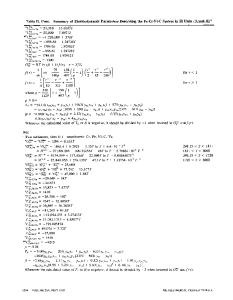Thermodynamic assessment of the Al-Fe-Si system
- PDF / 806,295 Bytes
- 15 Pages / 612 x 792 pts (letter) Page_size
- 102 Downloads / 550 Views
1. INTRODUCTION
THE effects of additional elements on the phase equilibria in alloys are of great importance in materials design and manufacture. The phase diagram, a graphic presentation of phase relationships and thermodynamic properties of an alloy system, is used extensively in the field of metallurgy and materials science. There are numerous compilations of phase diagrams and thermodynamic data. However, there is usually no check of consistency between the thermodynamic data and the suggested phase diagrams. Thermodynamic modeling is necessary if we want to couple the phase diagram and thermodynamic data. It is the only method by which various types of experimental information can be compared and the description of all the thermodynamic properties of a system can be optimized. This method is often referred to as the calculation of phase diagram (CALPHAD) method.[1] In this method, the thermodynamic properties of the alloy systems are analyzed by using thermodynamic models for the Gibbs energies of individual phases. The models involve adjustable parameters that are evaluated from the experimental thermodynamic and phase diagram information. This is made possible by increasingly powerful computers and computer programs. When a consistent description of the thermodynamic properties of the alloy system is obtained, in principle, any kind of diagram can be calculated, which is far beyond the scope of traditional compilations. The purpose of the present work, as part of our group’s systematic experimental and theoretical investigations of multicomponent aluminum alloys,[2–5] is to obtain a thermodynamic description of the Al-Fe-Si system. The Al-Fe-Si ternary system is of interest because iron and silicon are two of the most common impurities in aluminum alloys, and they exert a very pronounced influence upon the mechanical properties of these alloys. Several authors[6,7,8] investigated this ternary system. However, Kaufman[6] and Murry[7] only treated a few ternary compounds close to the Al corner, and the work mentioned by Kolby[8] may be more complete, but is not available in the open literature. ZI-KUI LIU, Assistant Professor, is with the Department of Materials Science and Engineering, The Pennsylvania State University, University Park, PA 16802. Y. AUSTIN CHANG, Distinguished Professor, is with the Department of Materials Science and Engineering, University of Wisconsin, Madison, WI 53706-1595. Manuscript submitted December 3, 1997. METALLURGICAL AND MATERIALS TRANSACTIONS A
The three constitutional binary descriptions used in the present work (Al-Fe,[9] Al-Si,[10] and Fe-Si[11]) have been evaluated with the same reference states and same description of the pure elements. The calculated phase diagrams from these descriptions are presented in Figures 1 through 3. The thermodynamic description of the Al-Fe system by Kattner and Burton[12] was not used here, because different reference states and lattice stabilities were used. In the following sections, the experimental information is first presented. The the
Data Loading...











